Asus RT-AC3100 User Manual
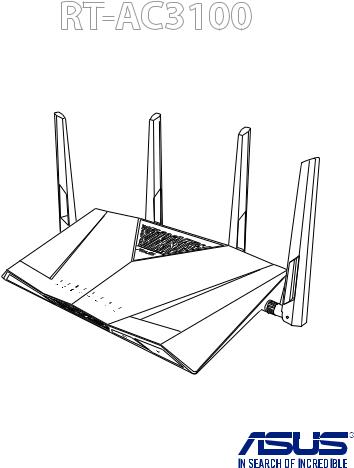
User Guide
RT-
 AC3100
AC3100
Wireless-AC 3100 Dual Band Gigabit Router

E10546
First Edition
June 2015
Copyright © 2015 ASUSTeK Computer Inc. All Rights Reserved.
No part of this manual, including the products and software described in it, may be reproduced, transmitted, transcribed, stored in a retrieval
system, or translated into any language in any form or by any means, except documentation kept by the purchaser for backup purposes, without the express written permission of ASUSTeK Computer Inc. (“ASUS”).
Product warranty or service will not be extended if: (1) the product is repaired, modified or altered, unless such repair, modification of alteration is authorized in writing by ASUS; or (2) the serial number of the product is defaced or missing.
ASUS PROVIDES THIS MANUAL “AS IS”WITHOUT WARRANTY OF ANY KIND, EITHER EXPRESS OR IMPLIED, INCLUDING BUT NOT LIMITED TO THE IMPLIED WARRANTIES OR CONDITIONS OF MERCHANTABILITY OR FITNESS FOR A PARTICULAR PURPOSE. IN NO EVENT SHALL ASUS, ITS DIRECTORS, OFFICERS, EMPLOYEES OR AGENTS BE LIABLE FOR ANY INDIRECT, SPECIAL, INCIDENTAL, OR CONSEQUENTIAL DAMAGES (INCLUDING DAMAGES FOR LOSS OF PROFITS, LOSS OF BUSINESS, LOSS OF USE OR DATA, INTERRUPTION OF BUSINESS
AND THE LIKE), EVEN IF ASUS HAS BEEN ADVISED OF THE POSSIBILITY OF SUCH DAMAGES ARISING FROM ANY DEFECT OR ERROR IN THIS MANUAL OR PRODUCT.
SPECIFICATIONS AND INFORMATION CONTAINED IN THIS MANUAL ARE FURNISHED FOR INFORMATIONAL USE ONLY, AND ARE SUBJECT TO CHANGE AT ANY TIME WITHOUT NOTICE, AND SHOULD NOT BE CONSTRUED AS A COMMITMENT BY ASUS. ASUS ASSUMES NO RESPONSIBILITY OR LIABILITY FOR ANY ERRORS OR INACCURACIES THAT MAY APPEAR IN THIS MANUAL, INCLUDING THE PRODUCTS AND SOFTWARE DESCRIBED IN IT.
Products and corporate names appearing in this manual may or may not be registered trademarks or copyrights of their respective companies, and are used only for identification or explanation and to the owners’ benefit, without intent to infringe.
2

Table of contents
1 |
Getting to know your wireless router |
|
|
1.1 |
Welcome!......................................................................................... |
7 |
|
1.2 |
Package contents.......................................................................... |
7 |
|
1.3 |
Your wireless router..................................................................... |
8 |
|
1.4 |
Positioning your router............................................................ |
10 |
|
1.5 |
Setup Requirements................................................................. |
11 |
|
1.6 |
Router Setup................................................................................ |
12 |
|
|
1.6.1 |
Wired connection.................................................................. |
12 |
|
1.6.2 |
Wireless connection.............................................................. |
13 |
2 |
Getting started |
|
2.1 |
Logging into the Web GUI...................................................... |
15 |
2.2 |
Quick Internet Setup (QIS) with Auto-detection............ |
16 |
2.3 |
Connecting to your wireless network................................ |
19 |
3 |
Configuring the General settings |
|
|
3.1 |
Using the Network Map ......................................................... |
20 |
|
|
3.1.1 Setting up the wireless security settings...................... |
21 |
|
|
3.1.2 Managing your network clients....................................... |
23 |
|
|
3.1.3 Monitoring your USB device.............................................. |
24 |
|
3.2 |
Creating a Guest Network...................................................... |
27 |
|
3.3 |
AiProtection................................................................................. |
29 |
|
|
3.3.1 |
Network Protection............................................................... |
30 |
|
3.3.2 Setting up Parental Controls.............................................. |
34 |
|
3.4 |
Adaptive QoS.............................................................................. |
38 |
|
|
3.4.1 |
Bandwidth Monitor............................................................... |
38 |
|
3.4.2 |
QoS.............................................................................................. |
39 |
|
3.4.3 |
Web History............................................................................. |
40 |
|
3.4.4 |
Traffic Monitor......................................................................... |
41 |
3

Table of contents
3.5 |
Using the USB Application..................................................... |
42 |
|
|
3.5.1 Using AiDisk................................................................................ |
42 |
|
|
3.5.2 |
Using Servers Center............................................................ |
44 |
|
3.5.3 |
3G/4G......................................................................................... |
49 |
3.6 |
Using AiCloud 2.0...................................................................... |
50 |
|
|
3.6.1 |
Cloud Disk................................................................................ |
51 |
|
3.6.2 |
Smart Access........................................................................... |
53 |
|
3.6.3 |
Smart Sync............................................................................... |
54 |
4 |
Configuring the Advanced Settings |
|
|
4.1 |
Wireless......................................................................................... |
55 |
|
|
4.1.1 |
General...................................................................................... |
55 |
|
4.1.2 |
WPS............................................................................................. |
57 |
|
4.1.3 |
Bridge......................................................................................... |
59 |
|
4.1.4 |
Wireless MAC Filter................................................................ |
61 |
|
4.1.5 |
RADIUS Setting....................................................................... |
62 |
|
4.1.6 |
Professional.............................................................................. |
63 |
4.2 |
LAN.................................................................................................. |
|
65 |
|
4.2.1 |
LAN IP......................................................................................... |
65 |
|
4.2.2 |
DHCP Server............................................................................ |
66 |
|
4.2.3 |
Route.......................................................................................... |
68 |
|
4.2.4 |
IPTV............................................................................................. |
69 |
4.3 |
WAN................................................................................................ |
|
70 |
|
4.3.1 |
Internet Connection............................................................. |
70 |
|
4.3.2 |
Dual WAN.................................................................................. |
73 |
|
4.3.3 |
Port Trigger.............................................................................. |
74 |
|
4.3.4 |
Virtual Server/Port Forwarding......................................... |
76 |
|
4.3.4 |
DMZ............................................................................................ |
79 |
|
4.3.5 |
DDNS.......................................................................................... |
80 |
|
4.3.6 |
NAT Passthrough.................................................................... |
81 |
4

Table of contents
4.4 |
IPv6................................................................................................. |
|
82 |
4.5 |
VPN Server.................................................................................... |
83 |
|
4.6 |
Firewall.......................................................................................... |
84 |
|
|
4.6.1 |
General...................................................................................... |
84 |
|
4.6.2 |
URL Filter................................................................................... |
84 |
|
4.6.3 |
Keyword filter.......................................................................... |
85 |
|
4.6.4 |
Network Services Filter........................................................ |
86 |
|
4.6.5 |
IPv6 Firewall............................................................................. |
87 |
4.7 |
Administration............................................................................ |
88 |
|
|
4.7.1 |
Operation Mode..................................................................... |
88 |
|
4.7.2 |
System....................................................................................... |
89 |
|
4.7.3 |
Firmware Upgrade................................................................. |
90 |
|
4.7.4 |
Restore/Save/Upload Setting............................................ |
91 |
4.8 |
System Log................................................................................... |
92 |
|
5 |
Utilities |
|
5.1 |
Device Discovery........................................................................ |
93 |
5.2 |
Firmware Restoration............................................................... |
94 |
5.3 |
Setting up your printer server............................................... |
95 |
|
5.3.1 ASUS EZ Printer Sharing...................................................... |
95 |
|
5.3.2 Using LPR to Share Printer.................................................. |
99 |
5.4 |
Download Master.................................................................... |
104 |
|
5.4.1 Configuring Bit Torrent download settings............... |
105 |
|
5.4.2 NZB settings......................................................................... |
106 |
5

Table of contents |
|
|
6 |
Troubleshooting |
|
6.1 |
Basic Troubleshooting............................................................ |
107 |
6.2 |
Frequently Asked Questions (FAQs) ................................. |
109 |
Appendices |
|
|
Notices ..................................................................................................... |
118 |
|
ASUS Contact information................................................................... |
132 |
|
Networks Global Hotline Information............................................. |
133 |
|
6
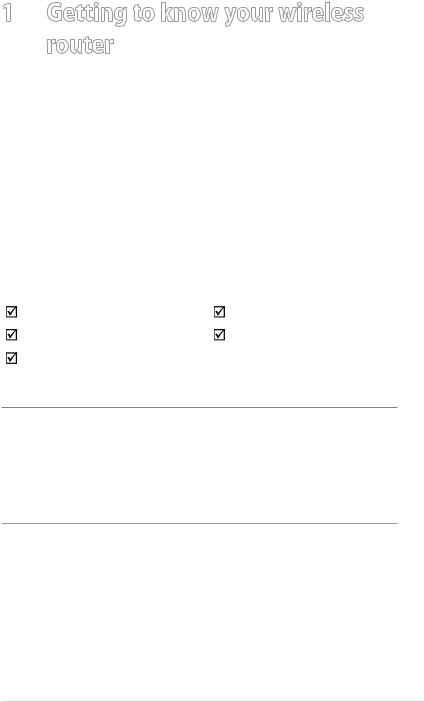
1Getting to know your wireless router
1.1 Welcome!
Thank you for purchasing an ASUS RT-AC3100 Wireless Router!
The ultra-thin and stylish RT-AC3100 features 2.4GHz and 5GHz dual bands for an unmatched concurrent wireless HD streaming; SMB server, UPnP AV server, and FTP server for 24/7 file sharing; a capability to handle 300,000 sessions; and the ASUS Green Network Technology, which provides up to 70% power-saving solution.
1.2 Package contents
RT-AC3100 Wireless Router |
AC adapter |
Network cable (RJ-45) |
Quick Start Guide |
Support CD (Manual) |
|
NOTES:
•If any of the items is damaged or missing, contact ASUS for technical inquiries and support, Refer to the ASUS Support Hotline list at the back of this user manual.
•Keep the original packaging material in case you would need future warranty services such as repair or replacement.
7
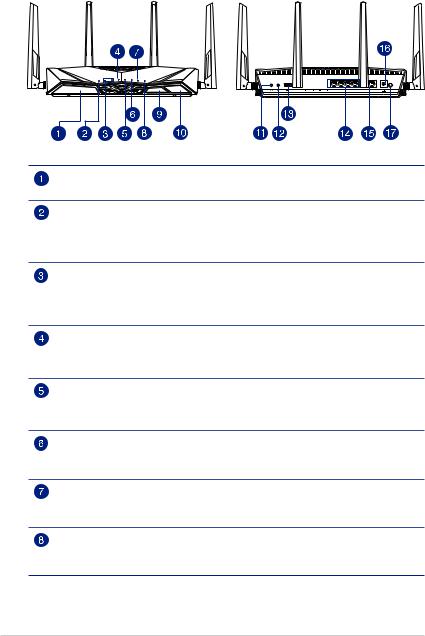
1.3 Your wireless router
WPS |
WiFi |
USB 3.0 port
Insert USB 3.0 devices such as USB hard disks or USB flash drives into this port.
Power LED
Off: No power.
On: Device is ready.
Flashing slow: Rescue mode
5GHz LED / 2.4GHz LED
Off: No 2.4GHz or 5GHz signal. On:Wireless system is ready.
Flashing:Transmitting or receiving data via wireless connection.
WAN (Internet) LED
Red: No IP or no physical connection.
On: Has physical connection to a wide area network (WAN).
LAN 1~4 LED
Off: No power or no physical connection.
On: Has physical connection to a local area network (LAN).
USB 3.0 LED
Off: No USB 3.0 device connected.
Flashing: USB 3.0 devices are running.
USB 2.0 LED
Off: No USB 2.0 device connected.
Flashing: USB 2.0 devices are running.
WPS LED
Off:WPS verification process is off or completed.
Flashing:WPS verification process is activated.
8

WPS LED On/Off button
Press this button to turn on/off the WPS LED on the panel.
Wi-Fi On/Off button
Press this button to turn on /off the Wi-Fi connection.
Reset button
This button resets or restores the system to its factory default settings.
WPS button
This button launches the WPS Wizard.
USB 2.0 port
Insert USB 2.0 devices such as USB hard disks or USB flash drives into this port.
LAN 1 ~ 4 ports
Connect network cables into these ports to establish LAN connection.
WAN (Internet) port
Connect a network cable into this port to establish WAN connection.
Power (DC-IN) port
Insert the bundled AC adapter into this port and connect your router to a power source.
Power button
Press this button to power on or off the system.
NOTES:
•Use only the adapter that came with your package. Using other adapters may damage the device.
•Specifications:
|
DC Power adapter |
DC Output: +19V with max 2.37A/3.42A current |
|
||
|
|
|
|
|
|
|
Operating |
0~40oC |
Storage |
0~70oC |
|
|
Temperature |
|
|
|
|
|
Operating Humidity |
50~90% |
Storage |
20~90% |
|
|
|
|
|
|
|
9

1.4 Positioning your router
For the best wireless signal transmission between the wireless router and the network devices connected to it, ensure that you:
•Place the wireless router in a centralized area for a maximum wireless coverage for the network devices.
•Keep the device away from metal obstructions and away from direct sunlight.
•Keep the device away from 802.11g or 20MHz onlyWi-Fi devices, 2.4GHz computer peripherals, Bluetooth devices, cordless phones, transformers, heavy-duty motors, fluorescent lights, microwave ovens, refrigerators, and other industrial equipment to prevent signal interference or loss.
•Always update to the latest firmware.Visit the ASUS website at http://www.asus.com to get the latest firmware updates.
•To ensure the best wireless signal,orient the four detachable antennas as shown in the drawing below.
45° |
45° |
WPS |
WiFi |
10

1.5 Setup Requirements
To set up your wireless network, you need a computer that meets the following system requirements:
•Ethernet RJ-45 (LAN) port (10Base-T/100Base-TX/
1000BaseTX)
•IEEE 802.11a/b/g/n/ac wireless capability
•An installedTCP/IP service
•Web browser such as Internet Explorer, Firefox, Safari, or
Google Chrome
NOTES:
•If your computer doesnot have built-in wireless capabilities, youmay install an IEEE 802.11a/b/g/n/ac WLAN adapter to your computer to connect to the network.
•With its dual band technology, your wireless router supports 2.4GHz and 5GHz wireless signals simultaneously. This allows you to do Internet-related activities such as Internet surfing or reading/writing e-mail messages using the 2.4GHz band while simultaneously streaming high-definition audio/video files such as movies or music using the 5GHz band.
•SomeIEEE802.11ndevicesthatyouwanttoconnecttoyournetwork may or may not support 5GHz band. Refer to the device's manual for specifications.
•The Ethernet RJ-45 cables that will be used to connect the network devices should not exceed 100 meters.
11
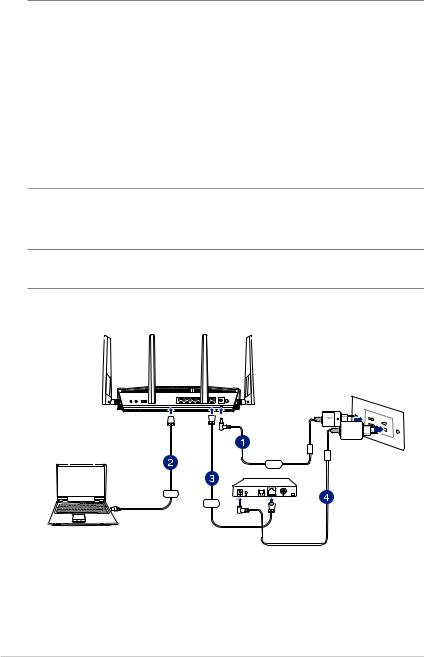
1.6 Router Setup
IMPORTANT!
•Use a wired connection when setting up your wireless router to avoid possible setup problems.
•Before setting up your ASUS wireless router, do the following:
•If you are replacing an existing router, disconnect it from your network.
•Disconnect the cables/wires from your existing modem setup. If your modem has a backup battery, remove it as well.
•Reboot your cable modem and computer (recommended).
1.6.1 Wired connection
NOTE: You can use either a straight-through cable or a crossover cable for wired connection.
Wall Power Outlet
RT-AC3100 |
Power
Modem
LAN
WAN
Computer
To set up your wireless router via wired connection:
1.Insert your wireless router’s AC adapter to the DC-IN port and plug it to a power outlet.
12
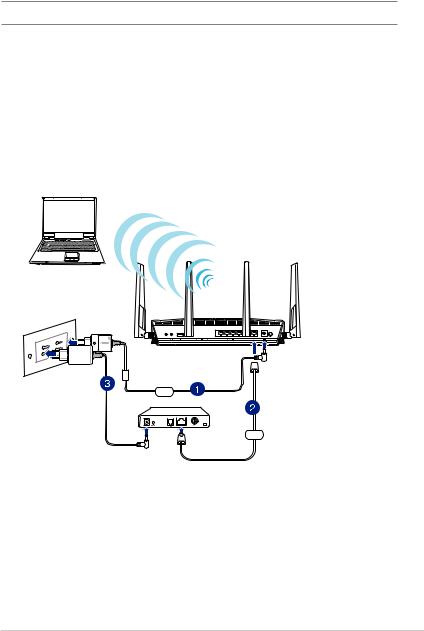
2.Using the bundled network cable, connect your computer to your wireless router’s LAN port.
IMPORTANT! Ensure that the LAN LED is blinking.
3Using another network cable, connect your modem to your wireless router’s WAN port.
4.Insert your modem’s AC adapter to the DC-IN port and plug it to a power outlet.
1.6.2 Wireless connection
Computer
Wall Power Outlet
RT-AC3100
Power
WAN
To set up your wireless router via wireless connection:
1.Insert your wireless router’s AC adapter to the DC-IN port and plug it to a power outlet.
2Using the bundled network cable, connect your modem to your wireless router’s WAN port.
13

3.Insert your modem’s AC adapter to the DC-IN port and plug it to a power outlet.
4.Install an IEEE 802.11a/b/g/n/ac WLAN adapter on your computer.
NOTES:
•For details on connecting to a wireless network, refer to theWLAN adapter’s user manual.
•To set up the security settings for your network, refer to the section
Setting up the wireless security settings in Chapter 3 of this user manual.
14
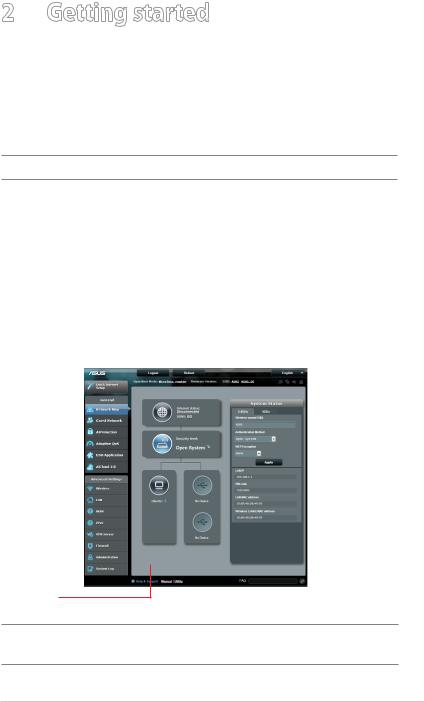
2 Getting started
2.1 Logging into the Web GUI
Your ASUS wireless router comes with an intuitive web graphical user interface (GUI) that allows you to easily configure its various features through a web browser such as Internet Explorer, Firefox, Safari, or Google Chrome.
NOTE: The features may vary with different firmware versions.
To log into the web GUI:
1.On your web browser, manually key in the wireless router’s default IP address: http://router.asus.com.
2.On the login page, key in the default user name (admin) and password (admin).
3.You can now use the Web GUI to configure various settings of your ASUS Wireless Router.
|
|
|
|
|
|
|
Top command buttons |
||||||||||||||
QIS - Smart |
|
|
|
|
|
|
|
|
|
|
|
|
|
|
|
|
|
|
|
Information |
|
|
|
|
|
|
|
|
|
|
|
|
|
|
|
|
|
|
|
|
|||
|
|
|
|
|
|
|
|
|
|
|
|
|
|
|
|
|
|
|
|||
|
|
|
|
|
|
|
|
|
|
|
|
|
|
|
|
|
|
|
|||
|
|
|
|
|
|
|
|
|
|
|
|
|
|
|
|
|
|
|
banner |
||
|
|
|
|
|
|
|
|
|
|
|
|
|
|
|
|
|
|
|
|||
Connect |
|
|
|
|
|
|
|
|
|
|
|
|
|
|
|
|
|
|
|
||
Wizard |
|
|
|
|
|
|
|
|
|
|
|
|
|
|
|
|
|
|
|
||
Navigation |
|
|
|
|
|
|
|
|
|
|
|
|
|
|
|
|
|
|
|
|
|
|
|
|
|
|
|
|
|
|
|
|
|
|
|
|
|
|
|
|
|
||
panel |
|
|
|
|
|
|
|
|
|
|
|
|
|
|
|
|
|
|
|
||
|
|
|
|
|
|
|
|
|
|
|
|
|
|
|
|
|
|
|
|
|
Right column |
|
|
|
|
|
|
|
|
|
|
|
|
|
|
|
|
|
|
|
|
|
|
|
|
|
|
|
|
|
|
|
|
|
|
|
|
|
|
|
|
|
|
|
|
|
|
|
|
|
|
|
|
|
|
|
|
|
|
|
|
|
|
|
|
|
|
Middle column
NOTE: If you are logging into the Web GUI for the first time, you will be directed to the Quick Internet Setup (QIS) page automatically.
15

2.2Quick Internet Setup (QIS) with Autodetection
The Quick Internet Setup (QIS) function guides you in quickly setting up your Internet connection.
NOTE: When setting the Internet connection for the first time, press the Reset button on your wireless router to reset it to its factory default settings.
To use QIS with auto-detection:
1. Log into the Web GUI. The QIS page launches automatically.
NOTES:
•By default, the login username and password for your wireless router's Web GUI is admin. For details on changing your wireless router's login username and password, refer to section 4.6.2 System.
•The wireless router's login username and password is different from the 2.4GHz/5GHz network name (SSID) and security key. The wireless router's login username and password allows you to log into your wireless router's Web GUI to configure your wireless router's settings. The 2.4GHz/5GHz network name (SSID) and security key allows Wi-Fi devices to log in and connect to your 2.4GHz/5GHz network.
16

2.The wireless router automatically detects if your ISP connection type is Dynamic IP, PPPoE, PPTP and L2TP. Key in the necessary information for your ISP connection type.
IMPORTANT! Obtain the necessary information from your ISP about the Internet connection type.
for Automatic IP (DHCP)
for PPPoE, PPTP and L2TP
17
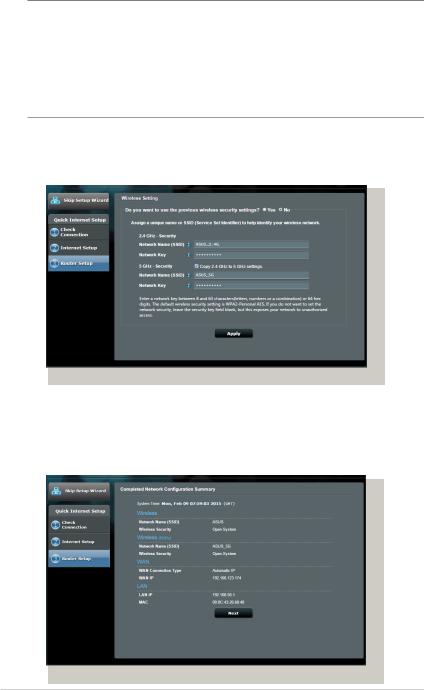
NOTES:
•The auto-detection of your ISP connection type takes place when you configure the wireless router for the first time or when your wireless router is reset to its default settings.
•If QIS failed to detect your Internet connection type, click Skip to manual setting and manually configure your connection settings.
3.Assign the wireless network name (SSID) and security key for your 2.4GHz and 5 GHz wireless connection. Click Apply when done.
4.Your Internet and wireless settings are displayed. Click Next to continue.
5.Read the wireless network connection tutorial. When done, click Finish.
18

2.3 Connecting to your wireless network
After setting up your wireless router via QIS, you can connect your computer or other smart devices to your wireless network.
To connect to your network:
1.On your computer, click the network icon  in the notification area to display the available wireless networks.
in the notification area to display the available wireless networks.
2.Select the wireless network that you want to connect to, then click Connect.
3.You may need to key in the network security key for a secured wireless network, then click OK.
4.Wait while your computer establishes connection to the wireless network successfully. The connection status is
displayed and the network icon displays the connected  status.
status.
NOTES:
•Refer to the next chapters for more details on configuring your wireless network's settings.
•Refer to your device's user manual for more details on connecting it to your wireless network.
19
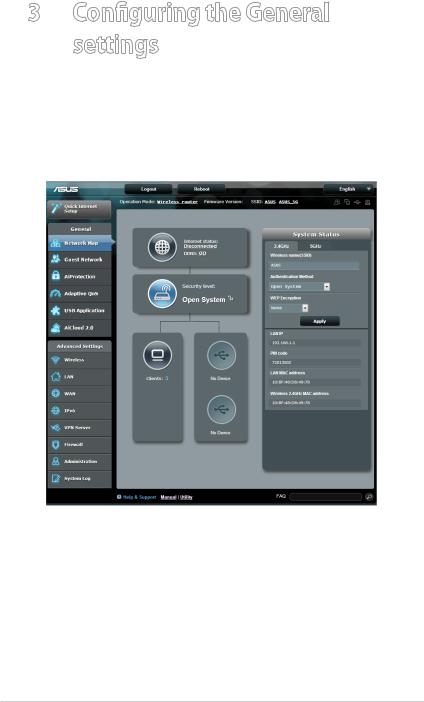
3Configuring the General settings
3.1 Using the Network Map
Network Map allows you to configure your network’s security settings, manage your network clients, and monitor your USB device.
20
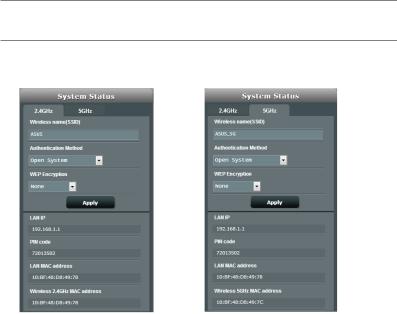
3.1.1 Setting up the wireless security settings
To protect your wireless network from unauthorized access, you need to configure its security settings.
To set up the wireless security settings:
1.From the navigation panel, go to General > Network Map.
2.On the Network Map screen and under System status, you can configure the wireless security settings such as SSID, security level, and encryption settings.
NOTE: You can set up different wireless security settings for 2.4GHz and 5GHz bands.
2.4GHz security settings |
5GHz security settings |
|
||
|
|
|
|
|
|
|
|
|
|
|
|
|
|
|
21

3. On the Wireless name (SSID) field, key in a unique name for your wireless network.
4.From the Authentication Method dropdown list, select the authentication method for your wireless network.
If you select WPA-Personal or WPA-2 Personal as the authentication method,key in theWPA-PSK key or security passkey.
IMPORTANT! The IEEE 802.11n/ac standard prohibits using High Throughput with WEP or WPA-TKIP as the unicast cipher. If you use these encryption methods, your data rate will drop to IEEE 802.11g 54Mbps connection.
5 Click Apply when done.
22
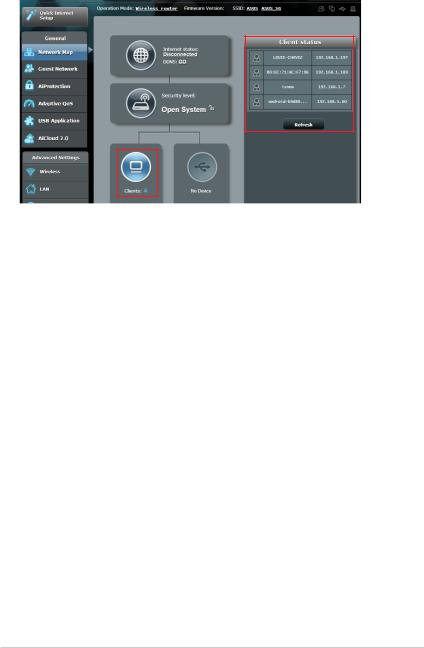
3.1.2 Managing your network clients
To manage your network clients:
1.From the navigation panel, go to General > Network Map tab.
2.On the Network Map screen, select the Clients icon to display your network client’s information.
3.To block a client’s access to your network, select the client and click the open lock icon.
23
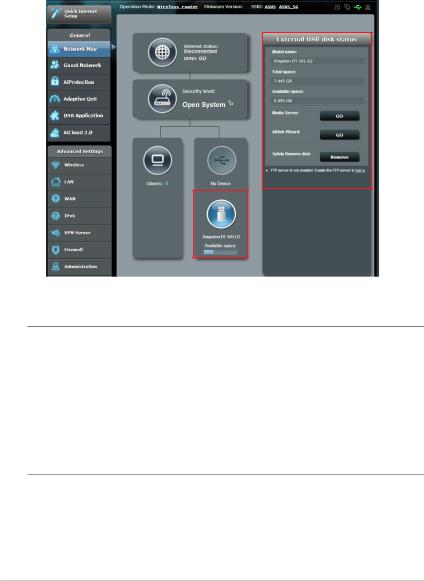
3.1.3 Monitoring your USB device
The ASUS wireless router provides two USB ports for connecting USB devices or USB printer to allow you to share files and printer with clients in your network.
NOTES:
•To use this feature, you need to plug a USB storage device, such as a
USB hard disk or USB flash drive, to the USB 3.0/2.0 ports on the rear panel of your wireless router. Ensure that the USB storage device is formatted and partitioned properly. Refer to the Plug-n-Share Disk Support List at http://event.asus.com/networks/disksupport
•The USB ports support two USB drives or one printer and one USB drive at the same time.
24

IMPORTANT! You first need to create a share account and its permission /access rights to allow other network clients to access the USB device via an FTP site/third-party FTP client utility, Servers Center, Samba, or AiCloud. For more details, refer to the section 3.5 Using the USB Application and 3.6 Using AiCloud in this user manual.
To monitor your USB device:
1.From the navigation panel, go to General > Network Map.
2.On the Network Map screen,select the USB Disk Status icon to display your USB device’s information.
3.On the AiDisk Wizard field, click GO to set up an FTP server for Internet file sharing.
NOTES:
•For more details, refer to the section 3.5.2 Using Servers Center in this user manual.
•The wireless router works with most USB HDDs/Flash disks (up to
4TB size) and supports read-write access for FAT16, FAT32, NTFS, and HFS+.
25
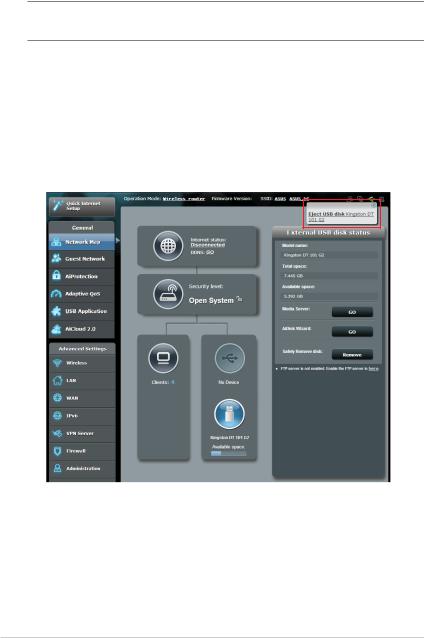
Safely removing the USB disk
IMPORTANT: Incorrect removal of the USB disk may cause data corruption.
To safely remove the USB disk:
1.From the navigation panel, go to General > Network Map.
2.In the upper right corner, click  > Eject USB disk. When the USB disk is ejected successfully, the USB status shows
> Eject USB disk. When the USB disk is ejected successfully, the USB status shows
Unmounted.
26
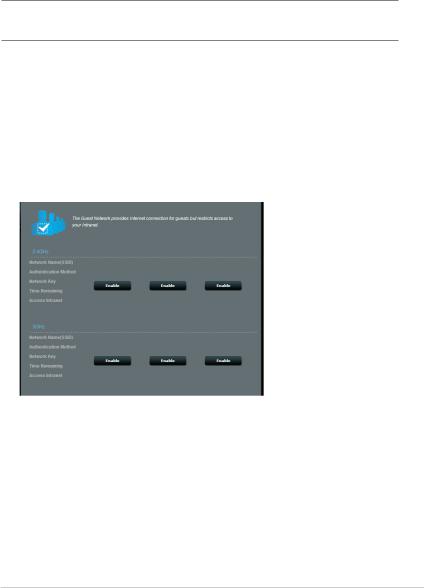
3.2 Creating a Guest Network
The Guest Network provides temporary visitors with Internet connectivity via access to separate SSIDs or networks without providing access to your private network.
NOTE: RT-AC3100 supports up to six SSIDs (three 2.4GHz and three 5GHz SSIDs).
To create a guest network:
1.From the navigation panel, go to General > Guest Network.
2.On the Guest Network screen, select 2.4Ghz or 5Ghz frequency band for the guest network that you want to create.
3.Click Enable.
27
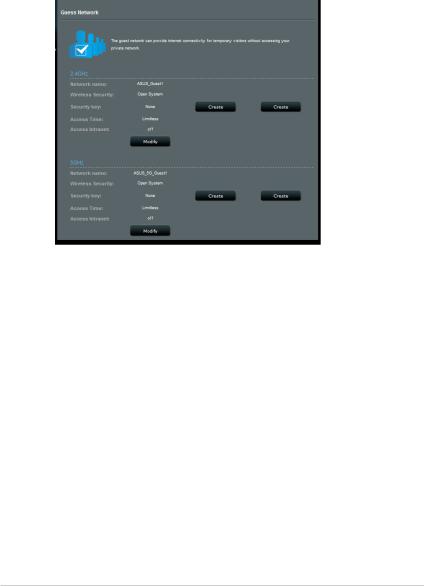
4.To change a guest’s settings, click the guest settings you want to modify. Click Remove to delete the guest’s settings.
5.Assign a wireless name for your temporary network on the Network Name (SSID) field.
6.Select an Authentication Method.
7.If you select a WPA authentication method, select a WPA Encryption.
8.Specify the Access time or choose Limitless.
9.Select Disable or Enable on the Access Intranet item.
10.When done, click Apply.
28
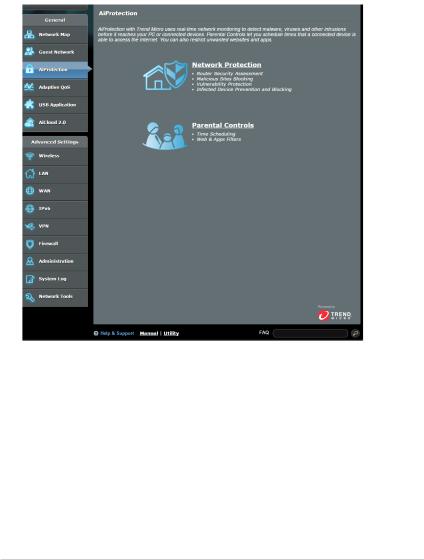
3.3 AiProtection
AiProtection provides real-time monitoring that detects malware, spyware, and unwanted access. It also filters unwanted websites and apps and allows you to schedule a time that a connected device is able to access the Internet.
29
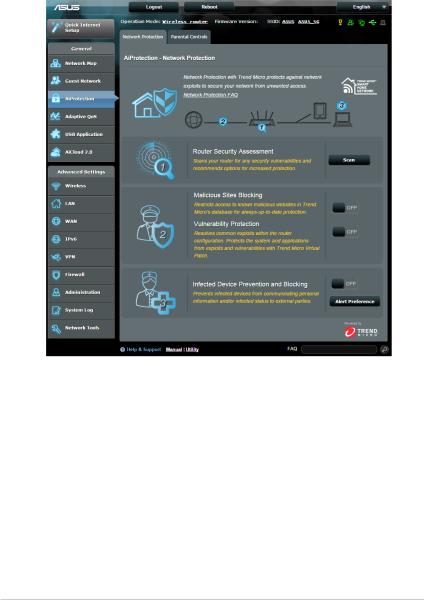
3.3.1 Network Protection
Network Protection prevents network exploits and secures your network from unwanted access.
Configuring Network Protection
To configure Network Protection:
1.From the navigation panel, go to General > AiProtection.
2.From the AiProtection main page, click on Network Protection.
3.From the Network Protection tab, click Scan.
When done scanning, the utility displays the results on the
Router Security Assessment page.
30
